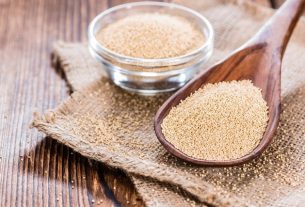Potassium is a very important and essential mineral for the proper functioning of the body, as it directly influences the nervous, muscular and cardiac systems and even the pH balance in the blood.
Therefore, having high or low potassium in the blood can lead to the appearance of various symptoms and health problems, from excessive tiredness to changes in heart rate and fainting. Understand better what potassium is and what it is for.
Therefore, the doctor can order a blood test to assess potassium levels whenever symptoms without a specific cause appear, in order to help with the diagnosis and adapt treatment.

Reference value in blood
The reference value for potassium in the blood is between 3.5 mEq/L and 5.5 mEq/L.
When this mineral is above or below the reference value, it can lead to some health complications.
Worried about your exam results?
High potassium
Excess potassium in the blood is called hyperkalemia or hyperkalemia.
When excess potassium is mild, it normally does not cause any type of symptoms, however when the concentration of this mineral becomes very high, symptoms such as reduced heart rate, palpitations, muscle weakness, numbness and vomiting may appear.
Causes of High Potassium
The main causes of high potassium are:
- Renal insufficiency;
- Diabetes type 1;
- Use of diuretic medications;
- Large bleeds or hemorrhages.
Diagnosis of the cause is made through complementary tests, such as a blood test, arterial blood gas analysis or electrocardiogram, for example.
How the treatment is carried out
Hyperkalemia is treated by removing foods rich in potassium from the diet.
In more serious cases, it may also be necessary to administer medication directly into the vein, which may require hospitalization until the condition improves. See what your diet should be like to lower potassium.
Read too: Hyperkalemia: what it is, symptoms, causes and treatment
Low potassium
The lack of potassium in the blood is known as hypokalemia or hypokalemia, and is a hydroelectrolyte disorder that occurs mainly in hospitalized people due to a decrease in the intake of foods that are sources of potassium or as a consequence of its excessive loss through the urine or gastrointestinal tract.
People with a lack of potassium typically experience symptoms such as weakness, fatigue, muscle cramps, tingling, numbness, cardiac arrhythmia and abdominal distension.
Causes of Low Potassium
The main causes of low potassium are:
- Use of medications such as insulin, salbutamol or theophylline;
- Prolonged vomiting or diarrhea;
- Hyperthyroidism;
- Hyperaldosteronism;
- Chronic use of laxatives;
- Cushing’s syndrome.
Furthermore, more rarely, low potassium can occur due to nutritional deficiencies.
Diagnosis of the cause is usually made through blood, urine, electrocardiogram or arterial blood gas tests.
How the treatment is carried out
Treatment for low potassium depends on the cause, the symptoms presented and the concentration of potassium in the blood, but the doctor generally recommends taking oral potassium supplements and consuming foods rich in this mineral. See foods rich in potassium to add to your diet.
In more serious cases, it may be necessary to administer potassium directly into a vein.
Read too: Hypokalemia: what it is, symptoms, causes and treatment
tuasaude.com/hipocalemia
Bibliography
- KIM, MJ; et al. Potassium Disorders: Hypokalemia and Hyperkalemia. Am Fam Physician. 107. 1; 59-70, 2023
- WEISS, JN; et al. Electrophysiology of Hypokalemia and Hyperkalemia. Circ Arrhythm Electrophysiol. 10. 3; e004667, 2017
- HIRSCH, T. M.; BRAUN, D. Hypokalemia. JAPA. 34. 1; 50-51, 2021
- BLANCHARD, A. Pathophysiologic approach in genetic hypokalemia: An update. Ann Endocrinol (Paris). 84. 2; 298-307, 2023
- HUNTER, R. W.; BAILEY, M. A. Hyperkalemia: pathophysiology, risk factors and consequences. Nephrol Dial Transplant. 34. Suppl 3; iii2-iii11, 2019
- EBSERH PROTOCOLS. SODIUM AND POTASSIUM DISORDERS. Disponível em: <http://www2.ebserh.gov.br/documents/214336/1108363/Cap%C3%ADtulo-11-Dist%C3%BArbios-do-S%C3%B3dio-e-do-Pot% C3%A1ssio.pdf/b975974b-a46c-4a9f-8629-d06078d58b28>. Accessed on March 30, 2020
- KARDALAS E et al. Hypokalemia: a clinical update. Endocrine Connections. 7. 4; 135-146, 2018

Sign up for our newsletter and stay up to date with exclusive news
that can transform your routine!
Warning: Undefined array key "title" in /home/storelat/public_html/wp-content/plugins/link-whisper-premium/templates/frontend/related-posts.php on line 12
Warning: Undefined array key "title_tag" in /home/storelat/public_html/wp-content/plugins/link-whisper-premium/templates/frontend/related-posts.php on line 13




